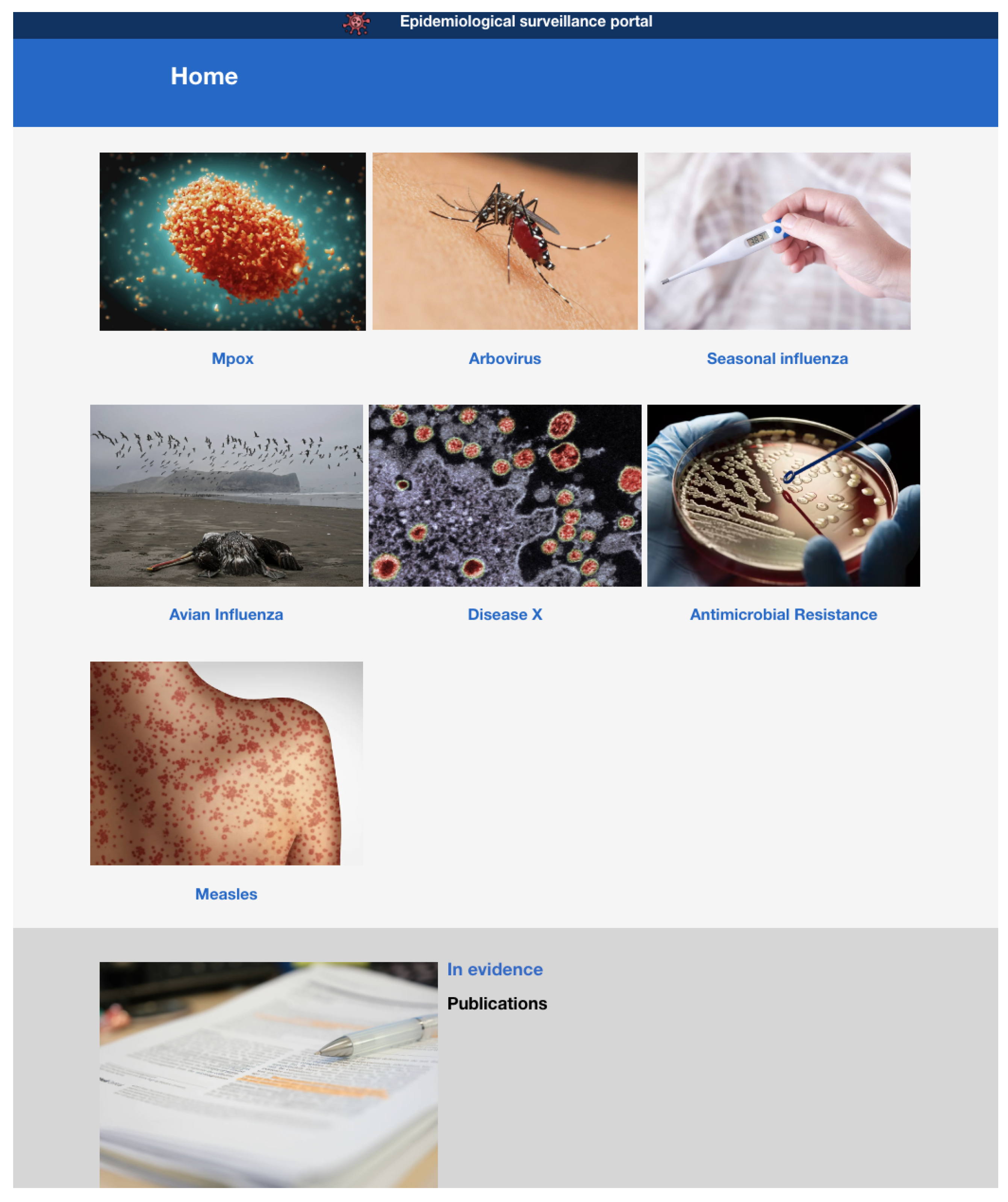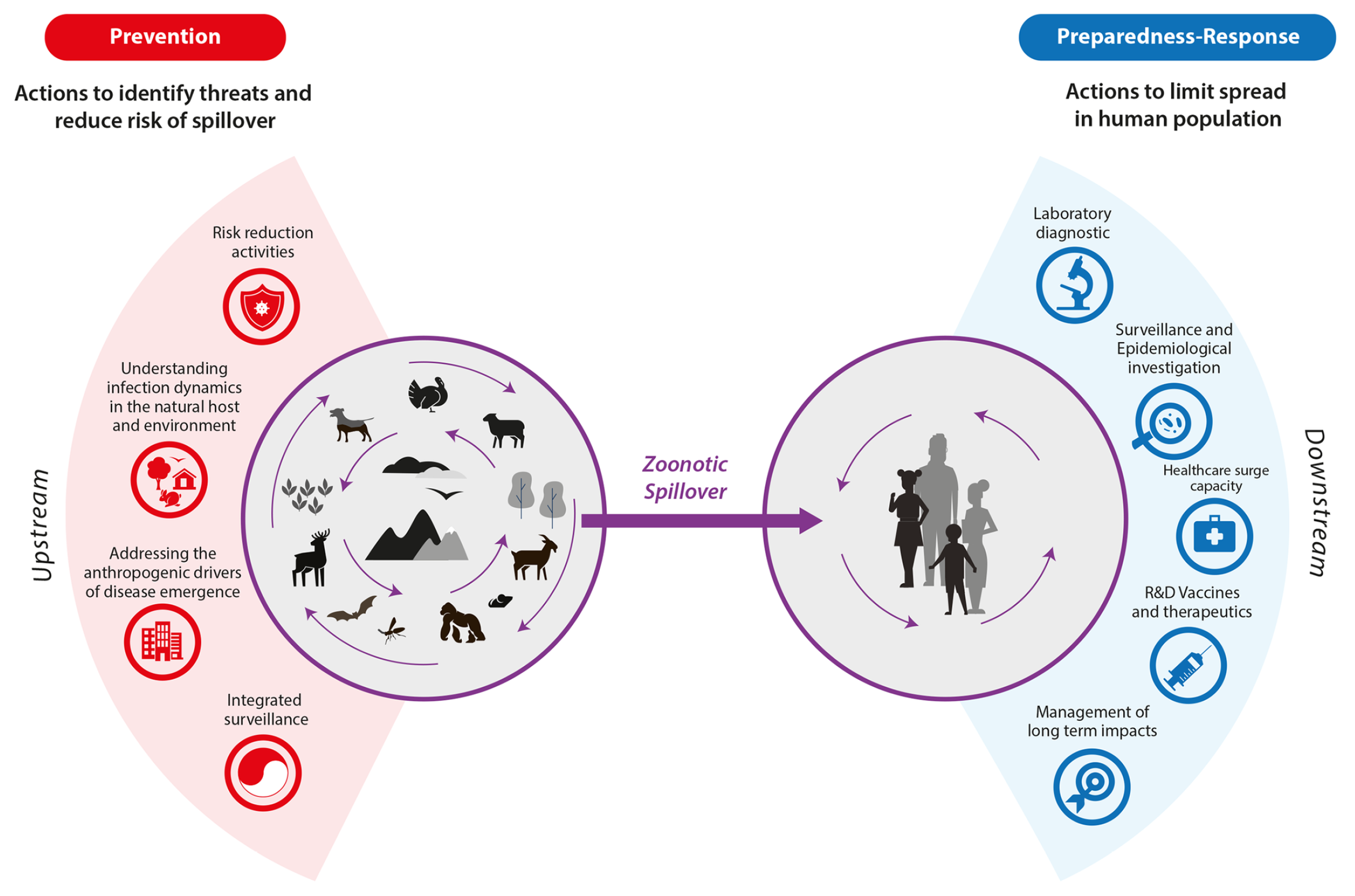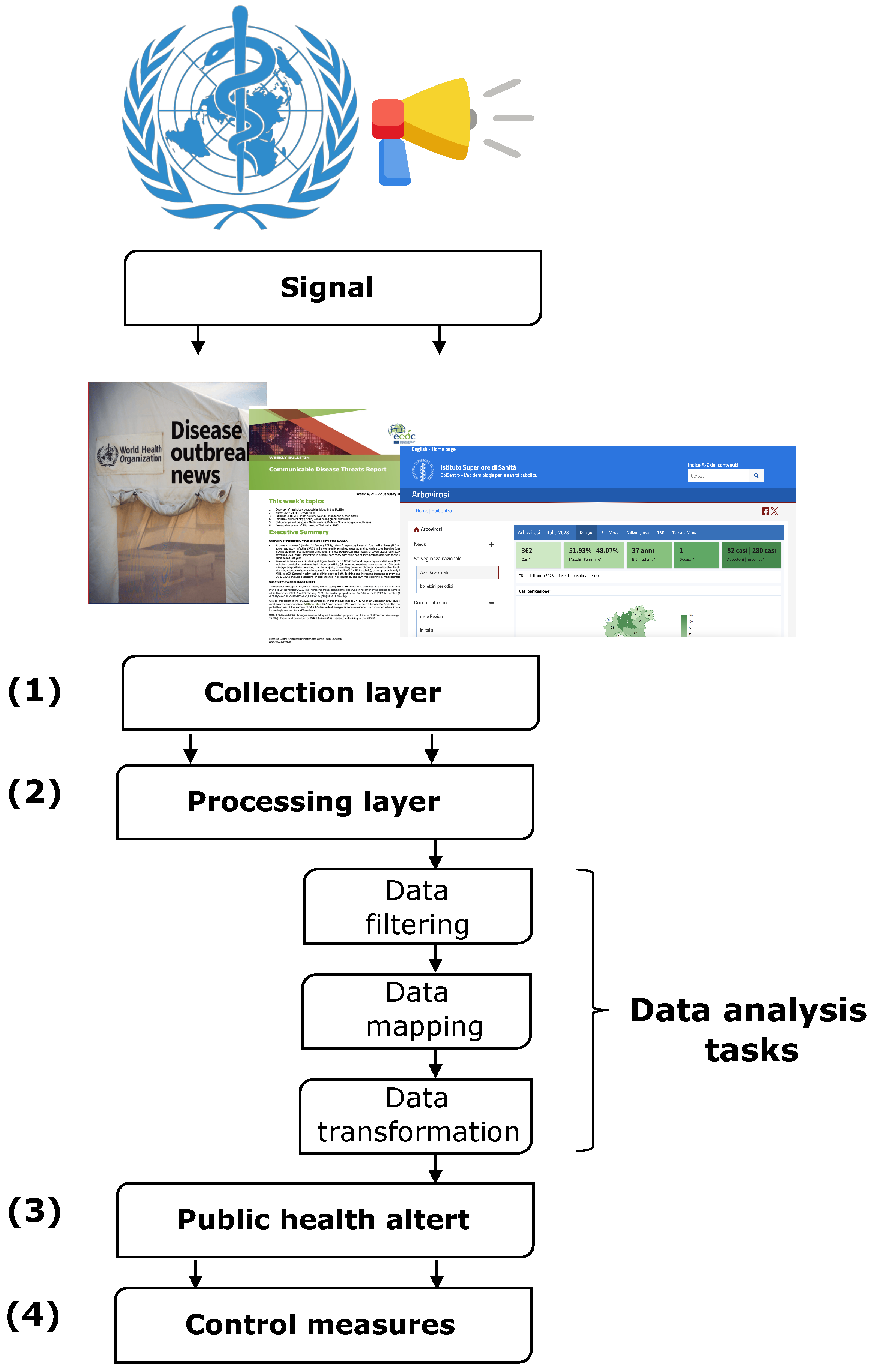A One Health Platform for Future Epidemic Preparedness
Abstract
1. Introduction
2. Proposed Platform
- 1.
- Understanding infection dynamics in the natural host and environment: Conduct comprehensive studies to unravel the complexities of pathogen interactions within natural hosts and ecosystems. This involves studying modes of transmission, reservoir species, and environmental factors that influence pathogen persistence and evolution.
- 2.
- Addressing the anthropogenic drivers of disease emergence: Identify and mitigate human-induced factors that contribute to disease outbreaks. This includes analyzing activities such as deforestation, urbanization, agricultural practices, and wildlife trade that can alter ecological balances and facilitate the spread of pathogens from animals to humans.
- 3.
- Risk reduction activities: Implement targeted measures to reduce the risk of disease transmission. This includes public health campaigns to educate communities, sustainable agricultural practices, enhanced biosecurity measures in high-risk areas, and promotion of responsible interactions between humans, animals, and the environment.
- 4.
- Integrated surveillance: Take a holistic approach to data collection, integrating information from different sources. This includes monitoring human and animal health, environmental conditions, and socioeconomic factors. Use advanced technologies such as real-time data analysis and artificial intelligence for effective surveillance to detect potential disease outbreaks early and support a coordinated response.
- 1.
- Laboratory diagnostics: A crucial element of this phase is the implementation of advanced and timely laboratory diagnostic systems. The ability to rapidly identify the pathogens responsible for an outbreak is critical to an effective response. This involves the rapid development and distribution of reliable diagnostic tests.
- 2.
- Surveillance and epidemiological investigation: An effective response requires active surveillance and thorough epidemiological investigation. Monitoring and understanding the spread of the pathogen is essential to identify outbreaks, take control measures, and prevent large-scale spread.
- 3.
- Healthcare surge capacity: Preparing for a sudden increase in cases requires capacity building in the healthcare system. This includes identifying and setting up additional facilities, training staff, and ensuring sufficient resources to ensure effective patient management.
- 4.
- R&D vaccines and therapeutics: The preparedness–response phase involves significant investment in the research and development of vaccines and therapies specific to the pathogen in question. This effort aims to ensure that once the pathogen is identified, there are therapeutic and preventive options ready to be implemented.
- 5.
- Management of long-term impacts: In addition to immediate response, the preparedness–response phase includes consideration of long-term public health impacts. This involves managing the psychological, social, and economic aspects, as well as planning for the long-term recovery of the affected community.
3. Limitations
- 1.
- ECIP bases much of its information on reports published by national and international health institutions and organizations. Although this provides a constant flow of epidemiological data, the dependence on external sources may make the platform vulnerable to delays or gaps in reporting. In addition, the accuracy and reliability of the data depend on the quality and timeliness of the reports provided, which may limit ECIP’s ability to provide a complete and up-to-date view of the epidemiological situation.
- 2.
- Because of the complexity of the epidemiological data and analyses on ECIP, users must have a solid understanding of the tools and methodologies used to analyze these data. This can be a barrier to access for those without specific training in epidemiology or data analysis, thus limiting the use of the platform to an inner circle of experts.
- 3.
- ECIP’s user experience capabilities may not be optimal for all users, especially those who prefer a more graphical and intuitive presentation of epidemiological data. Although the platform provides a number of data repositories that sometimes also contain tools for analyzing and interpreting data, some users may find the interface unintuitive or difficult to navigate. Currently, the platform lacks interactive features and advanced visualization tools that allow users to explore data more dynamically and intuitively.
4. Conclusions and Future Work
Supplementary Materials
Author Contributions
Funding
Data Availability Statement
Conflicts of Interest
References
- Dron, L.; Kalatharan, V.; Gupta, A.; Haggstrom, J.; Zariffa, N.; Morris, A.D.; Arora, P.; Park, J. Data capture and sharing in the COVID-19 pandemic: A cause for concern. Lancet Digit. Health 2022, 4, e748–e756. [Google Scholar] [CrossRef] [PubMed]
- Cake, C.; Ogburn, E.; Pinches, H.; Coleman, G.; Seymour, D.; Woodard, F.; Manohar, S.; Monsur, M.; Landray, M.; Dalton, G.; et al. Development and evaluation of rapid data-enabled access to routine clinical information to enhance early recruitment to the national clinical platform trial of COVID-19 community treatments. Trials 2022, 23, 62. [Google Scholar] [CrossRef] [PubMed]
- Kherabi, Y.; Launay, O.; Luong Nguyen, L.B. COVID-19 vaccines against Omicron variant: Real-world data on effectiveness. Viruses 2022, 14, 2086. [Google Scholar] [CrossRef] [PubMed]
- World Health Organization. Disease Outbreak News (DONs). Available online: https://www.who.int/emergencies/disease-outbreak-news (accessed on 20 January 2024).
- European Centre for Disease Prevention and Control. Disease Surveillance Reports. Available online: https://www.ecdc.europa.eu/en/search?s=&f%5B0%5D=categories%3A1253 (accessed on 15 January 2024).
- Istituto Superiore di Sanità. Health Topics. Available online: https://www.epicentro.iss.it/en/index/infectious-diseases (accessed on 21 January 2024).
- Branda, F.; Abenavoli, L.; Pierini, M.; Mazzoli, S. Predicting the Spread of SARS-CoV-2 in Italian Regions: The Calabria Case Study, February 2020–March 2022. Diseases 2022, 10, 38. [Google Scholar] [CrossRef] [PubMed]
- Branda, F.; Mazzoli, S.; Pierini, M.; Ciccozzi, M. Trends and Spatiotemporal Patterns of Avian Influenza Outbreaks in Italy: A Data-Driven Approach. Infect. Dis. Rep. 2023, 16, 1–12. [Google Scholar] [CrossRef] [PubMed]
- Mingione, M.; Branda, F.; Maruotti, A.; Ciccozzi, M.; Mazzoli, S. Monitoring the West Nile virus outbreaks in Italy using open access data. Sci. Data 2023, 10, 777. [Google Scholar] [CrossRef] [PubMed]
- Branda, F.; Mazzoli, S. The importance of rapid and robust availability of epidemiological data for real-time mapping of the risk of avian influenza a (H5N1) spread. Pathog. Glob. Health 2023, 117, 521–524. [Google Scholar] [CrossRef] [PubMed]
- Branda, F.; Pierini, M.; Mazzoli, S. Monkeypox: Early estimation of basic reproduction number R0 in Europe. J. Med. Virol. 2023, 95, e28270. [Google Scholar] [CrossRef] [PubMed]
- Cunningham, A.; Markotter, W.; Mettenleiter, T.C.; Adisasmito, W.B.; Almuhairi, S.; Barton Behravesh, C.; Bukachi, S.A.; Casas, N.; Cediel Becerra, N.; Charron, D.F.; et al. Prevention of zoonotic spillover: From relying on response to reducing the risk at source. Plos Pathog. 2023, 19, e1011504. [Google Scholar]



Disclaimer/Publisher’s Note: The statements, opinions and data contained in all publications are solely those of the individual author(s) and contributor(s) and not of MDPI and/or the editor(s). MDPI and/or the editor(s) disclaim responsibility for any injury to people or property resulting from any ideas, methods, instructions or products referred to in the content. |
© 2024 by the authors. Licensee MDPI, Basel, Switzerland. This article is an open access article distributed under the terms and conditions of the Creative Commons Attribution (CC BY) license (https://creativecommons.org/licenses/by/4.0/).
Share and Cite
Branda, F.; Scarpa, F.; Petrosillo, N.; Ciccozzi, M. A One Health Platform for Future Epidemic Preparedness. Infect. Dis. Rep. 2024, 16, 281-288. https://doi.org/10.3390/idr16020023
Branda F, Scarpa F, Petrosillo N, Ciccozzi M. A One Health Platform for Future Epidemic Preparedness. Infectious Disease Reports. 2024; 16(2):281-288. https://doi.org/10.3390/idr16020023
Chicago/Turabian StyleBranda, Francesco, Fabio Scarpa, Nicola Petrosillo, and Massimo Ciccozzi. 2024. "A One Health Platform for Future Epidemic Preparedness" Infectious Disease Reports 16, no. 2: 281-288. https://doi.org/10.3390/idr16020023
APA StyleBranda, F., Scarpa, F., Petrosillo, N., & Ciccozzi, M. (2024). A One Health Platform for Future Epidemic Preparedness. Infectious Disease Reports, 16(2), 281-288. https://doi.org/10.3390/idr16020023








